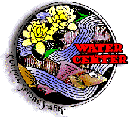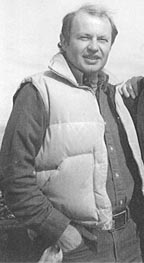
National Water Center, Eureka Springs, Arkansas

National Water Center, Eureka Springs, AR
Updated: April 2014 Contact: Contact: NWC
Contents ©1999-2014 by National Water Center. All rights reserved worldwide.
Water and Bioregionalism
by David Haenke
. . though we continually strive to develop new technologies to deal with our problems, the greatest innovation is conservation. David Haenke, 1983
Science Fiction is just that. Fiction. Plus Science, which is also made up primarily of fictions and illusions mixed up with its minor discernment's about the nature. Life on this spaces hip/living organism Earth on the other hand is real, wilder, more imaginative by far in every way, just about too wild in its full power for the mind to look at straight in the face, the reason why we come up with fictions to divert us with desperate entertainment. We can’t stand natural reality.
Yes, life on Earth is just so astounding in every dimension. The matter/energy patterns, forms, and interrelationships of the entire Earth are replicated in smaller and smaller versions in every single element that makes up the whole, the giant jewel box in space containing within it a nearly infinite number of ever smaller jewel boxes of forms and life forms nested one within the other down to the smallest molecular associations, everything either life, past life, or presaging life, everything mirroring and hologramming the totality, all without real boundaries in the enormity of Earth time, but rather all fully melded and ever intermixed. The “ordinary” on Earth is so astounding that we can’t begin to comprehend it or any part of it, and the “ordinary” so overpowers and mystifies us that we continually seek the “extraordinary” to divert us from the power all around us, seek “magic” as our minds dart in illusory journeys in the non-existent past and future to distract us from the magic that is all there is, and that saturates everything in the present.
All of it floats in the great waters, and the waters flow in their riverine patterns, tributary, vein, artery, capillary, vessel vapor, steam, mist through it all, magic every drop.
 As an organism Earth has some very large organs: oceans and continents. Continents further differentiate themselves. Nested in them are what geo-eco-cartographers have called “biogeographical provinces”. These vast areas have “boundaries” flowing about in geologic time that contain not only landforms but life forms that like to be in this home place and its climate. For instance, one of the biogeographic provinces in North America/Turtle Island is the great prairie that stretches from Canada down to Texas.
As an organism Earth has some very large organs: oceans and continents. Continents further differentiate themselves. Nested in them are what geo-eco-cartographers have called “biogeographical provinces”. These vast areas have “boundaries” flowing about in geologic time that contain not only landforms but life forms that like to be in this home place and its climate. For instance, one of the biogeographic provinces in North America/Turtle Island is the great prairie that stretches from Canada down to Texas.
Nested within the biogeographic provinces the smaller organs, bioregions, another, smaller sized home place defined both by landforms and the l living things that like to be there. Within the great prairie of North America, the Texas black land prairie, Red River Valley, and tall grass prairie bioregions.
Within bioregions, watersheds are the smaller organs, defining rivers f flowing within the high points, or under the land. And now we are getting closer to home.
Inside the watersheds, ecosystems, that forest over there, that swamp, that lake, this wetland, and now we are home.
In fact, here we are, our bodies, our very selves. Our bodies are just small hologramic Earth's, watersheds, and ecosystems, with the blood water flowing through, organizing systems of Earth, but, like everything else, Earth’s whole history, we and all a living, walking history of the Earth, a collection of highly cooperative and differentiated, mutated bacteria and the waters that it all came out of. Meanwhile your body and mine, inside and out, is swamp, jungle, forest, prairie, mountain, valley, and river to tens of millions, billions, of creatures that are sometime separate from, sometime part of the body, crawling, multiplying, fighting, eating each other, dying, recycling, mites, parasites, bacterial armies of friends and enemies, viruses, legions on eyebrows, hair, teeth, skin and organs. It all works as a phenomenally organized biologic community, four billion years in development, of a degree astounding in its order and complexity, far beyond all possible computers, and one that our cities might study and emulate in order that they have some chance to survive. Just like a watershed.
The bioregion, watershed, and ecosystem are of a scale that gets close enough to home and our capacities to rudimentary comprehend to be truly useful. Would that being able to clearly see the self-differentiation's of Earth was these easy, consistent, and neat, large to small: planet, continent, biogeographical province, bioregion, watershed, ecosystem. In actuality, there is no agreed upon map of the bioregions of any continent. Some watersheds are so big (the Missouri, the Mississippi, the Amazon) that they contain, or are one or more bioregions. Some watersheds are bioregions. Some cartographers consider the relatively small area of the Ozark/Ouachitas to be a biogeographical province. On the other hand, a bioregion like the Ozarks is wonderfully exemplary: clearly defined by both rivers and land forms, and divided up by watersheds.
But what always brings us home is water, and the watershed. Anyone who can’t define their bioregion can identify their watershed, because everyone on Earth lives in one. The watershed, and water, is the heart and center of bioregional understanding, even as water is the center and of all the nested jewel boxes of life on Earth. At the same time, the fluids wind and water sculpt and form everything we see in our watersheds and bioregions. The Ozarks that we look out over is, it is said, a 500 million year old, mile high plateau worn down to its present beautiful contours mostly by the action of the water of its watersheds.
From that identification of the watershed as home, all the ecological understandings, principles, practices of bioregionalism can be brought home and applied in that place. Ecological: technology, forestry, energy production, agriculture, health, protection, economics, “waste management” and recycling, architecture, communities, education, restoration social organization can be brought home, and implemented. If you want to forget the “eco” part, these are just the tried, true, and phenomenally successful operation principles and rules of the Earth translated into human understanding and practice, in the context of the watershed, Call it anything you want, a watershed that does these things will survive and thrive if allowed to do them. At the same time, without the implementation of these ecological ways in virtually every dimension of life, built from the level of the local ecosystem and watershed on up, there is no such thing as “sustainability”.
The integration of these ecological methodologies can restore and sustain any place on Earth, as surely as Earth will anyway, over time, without us, because these are the ways of Earth translated into human. And when the water that runs down through the middle of it runs clean we know it’s right. The organizing principle and the ultimate test for sustainability are one in the same.
Someday if there is a future for humans on Earth these things such as the full identity of the health of our human bodies and families with that of the watershed, its water, and all its life, along with the necessity of doing all things ecologically, will I believe be such a part of life as to be just like breathing, and not even a subject of discussion or thought. Just a part of the autonomic system of the human part of the watershed’s life. No doubt people will always find something to fight and argue about. But if we are still here 250 years from now, it won’t be about any of this.
No matter what, a river does run through it.
